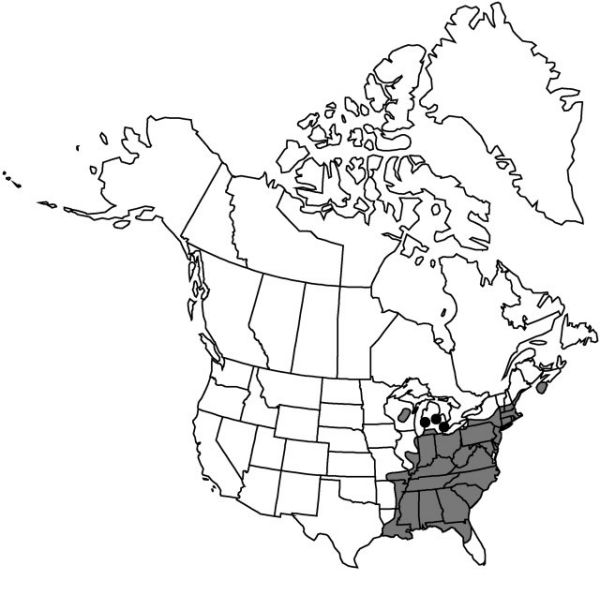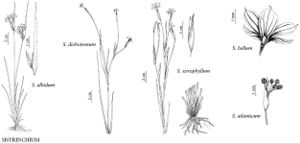Difference between revisions of "Sisyrinchium atlanticum"
Bull. Torrey Bot. Club 23: 134. 1896.
FNA>Volume Importer |
FNA>Volume Importer |
||
| Line 11: | Line 11: | ||
|name=Sisyrinchium apiculatum | |name=Sisyrinchium apiculatum | ||
|authority=E. P. Bicknell | |authority=E. P. Bicknell | ||
| + | |rank=species | ||
}} {{Treatment/ID/Synonym | }} {{Treatment/ID/Synonym | ||
|name=Sisyrinchium apiculatum var. mesochorum | |name=Sisyrinchium apiculatum var. mesochorum | ||
|authority=Nieuwland | |authority=Nieuwland | ||
| + | |rank=variety | ||
}} {{Treatment/ID/Synonym | }} {{Treatment/ID/Synonym | ||
|name=Sisyrinchium corymbosum | |name=Sisyrinchium corymbosum | ||
|authority=E. P. Bicknell | |authority=E. P. Bicknell | ||
| + | |rank=species | ||
}} {{Treatment/ID/Synonym | }} {{Treatment/ID/Synonym | ||
|name=Sisyrinchium flexile | |name=Sisyrinchium flexile | ||
|authority=Michaux | |authority=Michaux | ||
| + | |rank=species | ||
}} {{Treatment/ID/Synonym | }} {{Treatment/ID/Synonym | ||
|name=Sisyrinchium mucronatum var. atlanticum | |name=Sisyrinchium mucronatum var. atlanticum | ||
|authority=(E. P. Bicknell) H. E. Ahles | |authority=(E. P. Bicknell) H. E. Ahles | ||
| + | |rank=variety | ||
}} {{Treatment/ID/Synonym | }} {{Treatment/ID/Synonym | ||
|name=Sisyrinchium scoparium | |name=Sisyrinchium scoparium | ||
|authority=E. P. Bicknell | |authority=E. P. Bicknell | ||
| + | |rank=species | ||
}} {{Treatment/ID/Synonym | }} {{Treatment/ID/Synonym | ||
|name=Sisyrinchium tracyi | |name=Sisyrinchium tracyi | ||
|authority=E. P. Bicknell | |authority=E. P. Bicknell | ||
| + | |rank=species | ||
}} {{Treatment/ID/Synonym | }} {{Treatment/ID/Synonym | ||
|name=Sisyrinchium violaceum | |name=Sisyrinchium violaceum | ||
| − | |authority= | + | |authority= |
| + | |rank=species | ||
}} | }} | ||
|hierarchy=Iridaceae;Sisyrinchium;Sisyrinchium atlanticum | |hierarchy=Iridaceae;Sisyrinchium;Sisyrinchium atlanticum | ||
| Line 55: | Line 63: | ||
-->{{#Taxon: | -->{{#Taxon: | ||
name=Sisyrinchium atlanticum | name=Sisyrinchium atlanticum | ||
| − | |||
|authority=E. P. Bicknell | |authority=E. P. Bicknell | ||
|rank=species | |rank=species | ||
| Line 70: | Line 77: | ||
|publication year=1896 | |publication year=1896 | ||
|special status= | |special status= | ||
| − | |source xml=https://jpend@bitbucket.org/aafc-mbb/fna-data-curation.git/src/ | + | |source xml=https://jpend@bitbucket.org/aafc-mbb/fna-data-curation.git/src/f50eec43f223ca0e34566be0b046453a0960e173/coarse_grained_fna_xml/V26/V26_738.xml |
|genus=Sisyrinchium | |genus=Sisyrinchium | ||
|species=Sisyrinchium atlanticum | |species=Sisyrinchium atlanticum | ||
Revision as of 20:52, 16 December 2019
Herbs, perennial, cespitose, yellowish to light olive when dry, to 5.7 dm, not glaucous. Stems branched, with 1 or 2 nodes, 0.8–1.9 mm wide, usually glabrous, margins entire, similar in color and texture to stem body; first internode 11–36 cm, longer than leaves; distalmost node with 2–3 branches. Leaf blades usually glabrous, bases occasionally becoming fibrous, but not persistent in tufts. Inflorescences borne singly; spathes green or occasionally with purplish tinge on margins, obviously wider than supporting branch, glabrous or slightly scabrous, keels entire; outer 12–16.1 mm, 1.4 mm shorter to 1.5 mm longer than inner, tapering evenly towards apex, margins basally connate 3–5.2 mm; inner with keel evenly curved or straight, hyaline margins 0.2–0.6 mm wide, apex broadly rounded to truncate, usually erose, ending 0–0.5 mm proximal to green apex or, occasionally, exceeding it by up to 0.5 mm. Flowers: tepals light blue or bluish violet to purple or occasionally white, bases yellow; outer tepals 6.3–11 mm, apex emarginate to truncate, aristate; filaments connate ± entirely, stipitate-glandular basally; ovary blackish, in contrast with much lighter foliage. Capsules dark brown to black or purplish black, ± globose to obovoid, 2–4.1 mm; pedicel ascending to erect. Seeds globose to obconic, lacking obvious depression, 0.5–1.2 mm, rugulose or occasionally granular. 2n = 16, 32.
Phenology: Flowering spring–early summer.
Habitat: Moist meadows and coastal dunes in sandy, peaty, or rich, loamy soil
Elevation: 0–300 m
Distribution

N.S., Ala., Ark., Conn., Del., D.C., Fla., Ga., Ill., Ind., Ky., La., Maine, Md., Mass., Mich., Miss., Mo., N.H., N.J., N.Y., N.C., Ohio, Pa., R.I., S.C., Tenn., Vt., Va., W.Va., Wis.
Discussion
Selected References
None.
